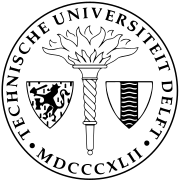
Back جامعة دلفت للتكنولوجيا Arabic جامعة دلفت للتكنولوجيا ARZ Delft Texnologiya Universiteti Azerbaijani دلفت تکنولوژی بیلیمیوردو AZB Дэлфцкі тэхнічны ўніверсітэт Byelorussian Universitat Tècnica de Delft Catalan Technická univerzita v Delftu Czech Technische Universiteit Delft Danish Technische Universität Delft German Teknika universitato Delft Esperanto
Technische Universiteit Delft | |
 | |
Former names | Koninklijke Akademie van Delft Polytechnische School van Delft Technische Hoogeschool van Delft |
|---|---|
Motto in English | Challenge the Future |
| Type | Public, Technical |
| Established | 1842[1] |
| Budget | € 914 million (2022)[2] |
| President | Prof.Dr.ir. T.H.J.J. (Tim) van der Hagen[3] |
| Rector | Prof.dr.ir. T.H.J.J. (Tim) van der Hagen[3] |
Academic staff | 4,461 (including 1,353 faculty members of all ranks, 29.9% female, 49.6% international, full-time equivalents in 2023) [4] |
Administrative staff | 2,804 (2023) |
| Students | 26,417 (2023) |
| Undergraduates | 13,568 (2023) |
| Postgraduates | 12,316 (2023) |
| 3,327 (2023) | |
| Location | , Netherlands 52°0′6″N 4°22′21″E / 52.00167°N 4.37250°E |
| Campus | Urban (University town) |
| Nobel Laureates | Jacobus van 't Hoff Simon van der Meer Heike Kamerlingh Onnes |
| Colors | Cyan, Black and White[5] |
| Affiliations | IDEA Climate-KIC CESAER EUA 4TU UNITECH SEFI SAE TPC ATHENS PEGASUS ENHANCE Alliance |
| Website | tudelft.nl/en/ |
 | |
The Delft University of Technology (TU Delft; Dutch: Technische Universiteit Delft) is the oldest and largest Dutch public technical university, located in Delft, Netherlands. As of 2022[update], it is ranked by QS World University Rankings among the top 10 Engineering and Technology universities in the world.[6] In 2023, it was ranked 2nd in the world in civil engineering, 3rd in the world in mechanical and aerospace engineering, and 3rd in the world in architecture.[7]
With eight faculties and numerous research institutes,[8] it has more than 26,000 students (undergraduate and postgraduate), 3,000 doctoral candidates, and 4,000 employees (teaching, research, support and management staff).[9]
The university was established on 8 January 1842 by King William II as a royal academy, with the primary purpose of training civil servants for work in the Dutch East Indies. The school expanded its research and education curriculum over time, becoming a polytechnic school in 1864 and an institute of technology (making it a full-fledged university) in 1905. It changed its name to Delft University of Technology in 1986.[1]
Dutch Nobel laureates Jacobus Henricus van 't Hoff, Heike Kamerlingh Onnes, and Simon van der Meer have been associated with TU Delft. TU Delft is a member of several university federations, including the IDEA League, CESAER, UNITECH International, ENHANCE Alliance, LDE, and 4TU.
- ^ a b "History of TU Delft". TU Delft. Archived from the original on 2008-02-28. Retrieved 2009-05-15.
- ^ "TU Delft – Annual Reports". TU Delft. Retrieved 2023-11-04.
- ^ a b "Executive Board". TU Delft. Retrieved 2018-06-20.
- ^ "Facts and Figures". TU Delft. Retrieved 2024-01-04.
- ^ "TU Delft corporate design: Colour". TU Delft. Retrieved 14 October 2022.
- ^ "QS World University Rankings - Engineering and Technology 2022". topUniversities. Retrieved 2022-04-11.
- ^ "Delft University of Technology". Top Universities. Retrieved 2023-09-20.
- ^ "Research institutes". TU Delft. Archived from the original on 2020-10-14. Retrieved 2019-01-02.
- ^ "Facts and Figures". TU Delft. Retrieved 2021-05-18.
© MMXXIII Rich X Search. We shall prevail. All rights reserved. Rich X Search